
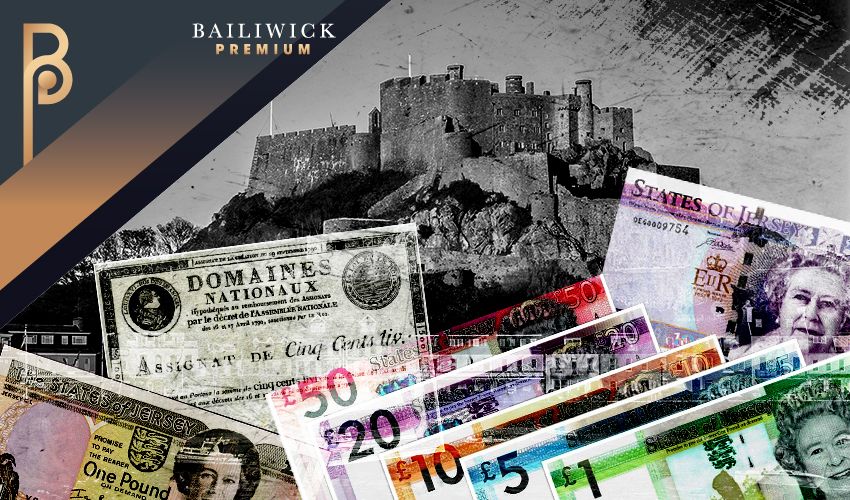

What is the story behind our banknotes? And how does our money make us more money? Express explores the little-known history of the island's banknotes.
It begins in 1941, when the States of Jersey first started to issue its own notes after most of the silver coins circulating in the island disappeared as the occupying forces took them as souvenirs. However, when the German Occupation ended in 1945, the States stopped issuing notes.
In July 1963, the States began again to regularly issue its own notes. Since then, Jersey has had its own currency, with the series of notes updated approximately every 10-20 years.
The former set of banknotes had been in circulation for more than twenty years and was in need of updated security features. The States of Jersey therefore took the opportunity to redesign the notes in 2010 and highlight different aspects of Jersey's diverse architecture, history and culture at the same time, leading to the modern Jersey banknotes that we have today.
Jersey’s first bank was opened in 1797 by wine merchant Hugh Godfray and Company, who issued their own £1 notes. As other private banks were formed, Godfray’s became known as the Jersey Old Bank.
Private banks mushroomed in the early part of the 19th century as trade grew between Jersey, Newfoundland and the wider world. Towards 1810 large amounts of low value notes were put into circulation by local people and businesses because there was a shortage of silver.
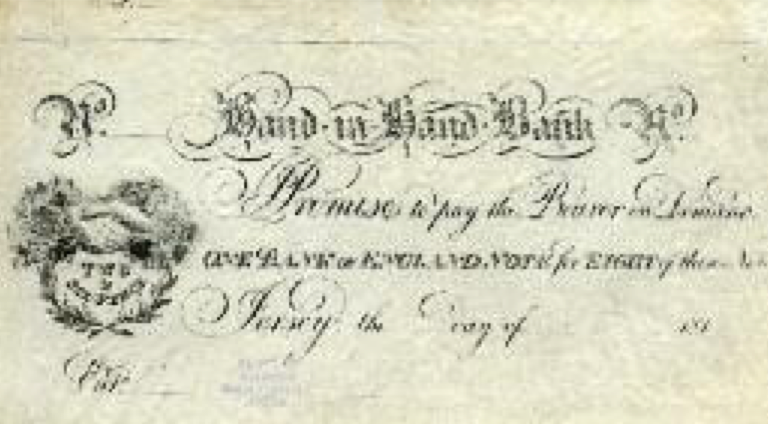
Pictured: The Hand in Hand Bank 2/6 note highlights one of the problems with low value notes – they could only be exchanged in multiple equivalents of £1.
Eventually, in 1813, the Island authorities stipulated that notes had to be for at least £1 and each organisation issuing them had to have a regular office.
From five issuing offices in 1814, there were more than a hundred by 1817, although many had closed by the following year. Although many of these early private banks grew from the expanding trade with Newfoundland, in 1808 Janvrin & Durell founded the Commercial Bank on the proceeds of a French sloop captured by their privateer, the Vulture.
In 1831, the States insisted that anyone issuing bank notes had to have two guarantors which meant that banks, and even churches and parishes, could issue their own notes.
The private banks were succeeded by local joint stock banks. In the 1870s, an economic recession caused the collapse of several of these banks and many local businesses and families were ruined.
Surviving local banks were caught up in a wave of mergers in the 20th century that created the main clearing banks of today.
It is interesting to note that in the 1858 Jersey Independent Almanack & Directory it states that the ‘Post Office Authorities are not allowed to take Jersey Bank notes, French coin or Jersey copper coin in payment for Post Office Orders or Stamps’.
During the Occupation most of the silver coins circulating in the island disappeared as the occupying forces took them as souvenirs.
The States were obliged to pass a special Currency Notes (Jersey) Law on 29 April 1941 which allowed the Finance Committee to issue up to £5,000 sterling in notes for two shillings. These had 2/- in blue lettering on orange paper and 50,000 were issued in June 1941.
It soon became obvious that this was not enough so an amendment to the law was passed on 29 November 1941 allowing a further issue of notes of various amounts up to the value of £100,000. The artist Edmund Blampied engraved the plates and they were printed in the Island. These various Blampied designed notes were issued between 1942 and 1945.
Once the island was liberated the States stopped issuing its own notes. The modern States of Jersey only started issuing its own notes and coins on a regular basis in July 1963.
On 29 April 2010, the most recent set of Jersey banknotes was issued. The notes are trilingual, containing text in English, French and Jèrriais. The new designs were publicly shown for the first time on 22 February 2010 and intended to “reflect the island’s rich cultural heritage, from Neolithic Times to the present day”.
The front of all notes includes a portrait of Queen Elizabeth II based on a photograph by Mark Lawrence, alongside a view of an important Jersey landmark, with text in English.
On Jersey notes, the Queen is wearing the Vladimir Tiara as opposed to a crown in recognition of her title in the island: the Duke of Normandy.
The reverse of each note includes an image of one of Jersey's numerous historic coastal defence towers, built in the late 18th century, as well as a further image of cultural or landscape importance, images of the twelve parish crests, and with denomination worded in French and Jèrriais.

The current £1 banknote has a fresh green colour scheme, with the main vignettes of the Monument to Freedom sculpture in Liberation Square on the front, and the Neolithic Ritual Site of La Hougue Bie on the back.
The Monument to Freedom in Liberation Square celebrates the momentous announcement of the liberation of the island from Nazi forces at the end of the Second World War. It was created by sculptor Philip Jackson in 1995 as part of the celebrations to commemorate 50 years of Jersey’s freedom from occupation.
It was from the balcony of the nearby Pomme D’Or Hotel that the Union flag was unfurled. In order to capture the unique moment of Liberation, Jackson based his work on photographs of the time showing the streets and squares of the Island teeming with jubilant Islanders and their liberators, all celebrating the joyous occasion.
La Hougue Bie is an ancient burial site, and one of the best-preserved remnants of the Neolithic period in the world. The site is estimated to originate from between 4000 and 3250 B.C., and was first excavated by the Société́ Jersiaise in 1924-25. The fragments of twenty vase supports were uncovered, along with the remains of several individuals and pieces of pottery. The mound is crowned by two medieval chapels.

The current £5 banknote has a sky blue colour scheme, with the main vignettes of Le Rât Cottage on the front and Les Augrès Manor on the back.
Le Rât Cottage is typical of small Jersey houses of the early seventeenth century, of which very few remain unaltered. Built from pink granite, the cottage has three bays and two stories and was initially thatched, although in the eighteenth or early nineteenth century the roof was replaced with English pantiles. Facing south to make the most of the sun’s warmth, the cottage has chimney stacks rising from the gable ends.
In 1937 the property was sold to the National Trust for Jersey, which was founded the previous year.
Les Augrès Manor is an impressive 16th century manor house in Trinity, the grounds of which now house the Durrell Wildlife Conservation Trust.
The Trust has the mission of saving species from extinction and houses 1400 mammals, birds, reptiles and amphibians in 32 acres of beautiful parkland. Since 1963, the manor house has been home to the Durrell family, including Gerald Durrell until his death in 1995.

The current £10 banknote has a burnt sienna colour scheme, with the main vignettes of The Hermitage at Elizabeth Castle on the front and the Lalique glass sculptures of St Matthew’s Church, St Lawrence on the back.
The Hermitage stands on the rock where the patron saint of Jersey lived and died. Saint Helier was sent to Jersey as a missionary in 545 A.D. He lived a hermit’s lifestyle during his fifteen years on the island but soon converted many of the Jersey population to Christianity. An annual pilgrimage continues to take place to the important heritage site of The Hermitage.
This medieval chapel was built in the twelfth century, the walls are made of granite rubble and the roof is made from flat stones set into mortar. The inside was plastered and when it was restored in the 1930s a small area in the southwest of the building was said to contain traces of a fresco.
Originally the rock was separated from the rest of Elizabeth Castle by the sea, but a breakwater was built in the late nineteenth century and the two were joined.
The Lalique glass sculptures at St Matthews Church are one of a kind and were the result of a 1935 commission by Lady Trent in memory of her late husband. The famous French glassmaker René Lalique collaborated with the Jersey architect A.B. Grayson to create this special sanctuary for worship.
This is one of the best examples in the world of the art nouveau style of the 1920s and 1930s.

The current £20 banknote has a cool violet colour scheme, and depicts the States Building in both its exterior view on the front and its interior States Chambers on the back.
The States Building is home to the Assembly of the States of Jersey, which is one of the oldest legislatures of the English-speaking world.
In 933 Jersey, with the other Channel Islands, was annexed by William Longsword, Duke of Normandy. In 1066 William, Duke of Normandy, defeated Harold at the Battle of Hastings and was crowned King of England.
From 1066 to 1204, England, Normandy and the Channel Islands were united under one rule - that of the King of England, who was also Duke of Normandy. In 1204, King John lost Normandy to the King of France and decreed that the Channel Islands should continue to be governed by the laws they were used to. A separate legal system therefore came into existence for Jersey and the other islands, which continues to this day.
Although the States Assembly has met on this site since the fifteenth century, it had no chamber of its own until the late eighteenth century. The present States Chamber was built on the eastern side of the Royal Court building and was opened on 21 June 1887 on the occasion of the 50th anniversary of the accession of Queen Victoria.
The first election by secret ballot was held on 1 December 1891.

The current £50 banknote has a red colour scheme, and carries the impressive outline of the medieval castle of Mont Orgueil on the front and the houses on the island of La Marmotière in Les Écréhous on the back.
Symbolising Jersey’s independence, the medieval castle at Gorey, Mont Orgueil (‘Mount Pride’) has stood guard over the island’s east coast for more than 800 years. It was built after England’s King John lost possession of Normandy to France in 1204. The castle withstood numerous attacks by the French and was only taken by force twice - in 1380 and again in 1461.
The castle’s importance was eclipsed by the construction of Elizabeth Castle. During the seventeenth century it was used as a political prison by the English Crown and in the late 1700s it served as headquarters for a counter-revolutionary spy network and as a refuge for aristocrats fleeing the French Revolution.
The Crown gave the castle to the States of Jersey in 1907 so it could be kept as an historic monument, the only interruption being during the Second World War, when the occupying German force adapted it to its own needs. In the last few years, extensive restoration has been undertaken.
Les Écréhous are a group of islands and rocks situated six miles north-east of Jersey (eight miles from France). They form part of the Bailiwick of Jersey and are administratively part of the Parish of St. Martin. There are no permanent residents on the islands, which are separated in places by impressive sandbanks, visible only at low tide.
Jersey banknotes have a range of features to aid recognition and to ensure that the public to have confidence in the validity of local currency. The simplest way to recognise a genuine banknote is to feel its texture. When you When you run your finger over the States of Jersey title, and denominational value, the ink should feel raised. The paper should be crisp, not limp, waxy or shiny.
When you hold the note up to the light, the watermark of the Jersey cow will come into view. The watermark should appear as shades of light and dark. When laid against a flat surface this image should also be partially visible as dark and light tones.
The watermark also has a particularly light area called the electrotype. This is the denomination (e.g. the number ‘20’ on a £20 note) which appears as a highlight against the watermark.
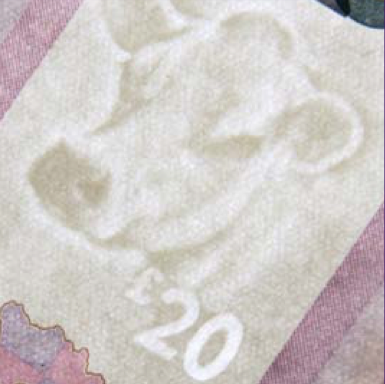
Pictured: Security watermark and electrotype as shown on a Jersey £20 banknote.
Watermark bars can also be found in the corners of the bank note. These are referred to as Cornerstone, and are designed to strengthen the corners of the banknote against wear and tear.
Beneath the watermark is the See-Through Feature, which is a map of Jersey which is partly filled with panels of colour. If you view this image against the light, it will fill in with colour from the reverse of the banknote therefore creating a complete image.
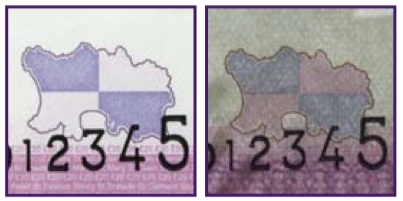
Pictured: Security See-Through Feature as shown on a Jersey £20 banknote against light and no light.
The security thread is visible only as separate silver dashes when the note is laid flat. However, when the banknote is held up to the light, the thread should show as a continuous line running through the note on the right-hand side when viewed from the front. The thread contains a complex metallised pattern which can be viewed from both sides of the banknote.
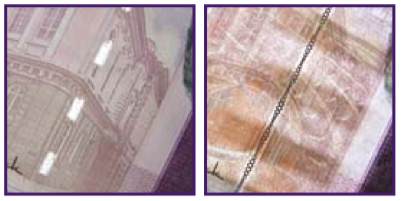
Pictured: Security thread as shown on a Jersey £20 banknote laid flat and against light.
There are additional security features on the larger £10, £20, and £50 notes.
There is a patch hologram on these larger notes which bears a central image which changes according to the viewing angle. From some angles the island of Jersey can be seen, from others the States of Jersey crest. Each hologram has a repeating background pattern of Corbière Lighthouse intermixed with the denominational value, which switches colour as the hologram is tilted.
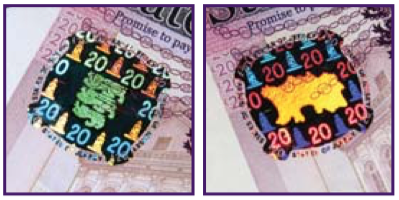
Pictured: Security hologram as shown on a Jersey £20 banknote from different angles.
The edges of the hologram are demetallized with the word Jersey, and each hologram is overprinted with a small amount of intaglio ink.
And of course, all the modern notes bear the signature of the Treasurer of the States, Ian Black, and each has its own unique serial number.
Jersey notes that are in circulation generate income for the Island. If we aren’t withdrawing Jersey cash from the banks, then the banks would have no need to buy notes from the States of Jersey. This is why the island benefits from having its own currency.
When we use Jersey notes, the island earns interest on the money in circulation. This is because when the States of Jersey issues Jersey notes to local banks, the banks pay for the cash.
Jersey’s banks order paper money from the States of Jersey to meet the demand for cash from their customers. Jersey notes enter circulation via the following process:
local banks place an order for cash with the States of Jersey Treasury
the Treasury issues Jersey notes to local banks
in return, the local banks pay the Treasury the face value of the cash received
the notes are withdrawn from local banks by Islanders
The money that the banks pay for the notes is invested by the States of Jersey and contributes to the overall running of the Island. In 2008, this generated £3.7 million for the island.
There is usually around £115 million of Jersey notes in circulation (as at end of 2020). This figure goes up at certain times of the year, for example at Christmas when islanders withdraw more cash from the banks.
Jersey has issued two commemorative £1 banknotes.
In 1995, a special issue commemorating the 50th anniversary of Liberation of Jersey was issued. The front side is slightly different from the standard design with the serial number starting "LJ" standing for "Liberation of Jersey" and a map of Jersey printed in optically variable ink. On the reverse is an entirely different design from the standard £1 note, featuring the £1 note issued during the Occupation of Jersey.
In 2004, a special edition £1 note was introduced in general circulation alongside the St. Helier Parish Church note; this commemorative note marks the 800th anniversary of the division of the Duchy of Normandy in 1204 and the design consequently includes Mont Orgueil castle and other historic symbols. It has serial number with prefix "J8C" which stands for "Jersey 800".
On 1 June 2012, a £100 note was issued to commemorate the Diamond Jubilee of Queen Elizabeth II. In order to issue a new £100 note, the States had to amend the existing 1959 law, which limited the maximum denomination of any currency note to £50.
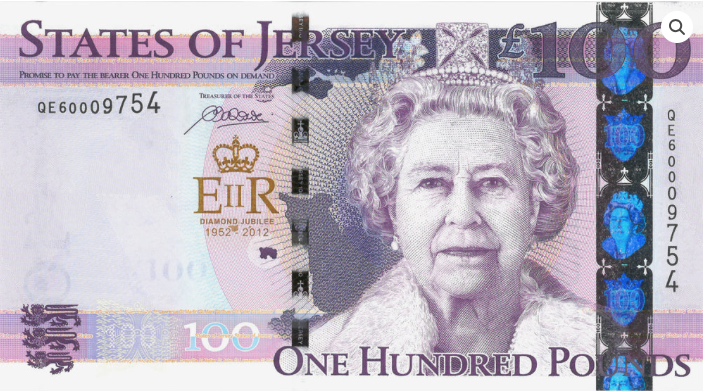
Pictured: The £100 note issued to commemorate the Diamond Jubilee of Queen Elizabeth II in June 2012.
The front of the £100 commemorative note features a portrait of The Queen based on Chris Levine's and Rob Munday's portrait of Her Majesty called "Equanimity", and the engraving was created by Stephen Matthews. On the back of the note is the Royal Mace of Jersey and the Flag of Jersey in a vertical view.
Updating Jersey notes and coins with portraits of King Charles III following the death of the Queen is a process likely to take years, according to the island's Treasury.
Officials said there were no existing plan in place for replacing currency in the event of a monarchs death, but that this "may lead to consideration of a new issue of notes and coins."
However, this is a process that could take "several years", with public consultation before the final designs are decided.
The final decision would be made by the Treasury Minister, who may also consult with "colleagues in other Crown Dependencies to adopt a collaborative approach to any issuance."

Pictured: The final decision on any redesigns of Jersey money rests with the Treasury Minister.
Jersey is unlikely to make any changes to its currency before the UK.
The issue, recall and replacement of the latest synthetic £50 banknotes by the Bank of England took around 16 months.
It confirmed in a statement on 8 September following the Queen's death: "Current banknotes featuring the image of Her Majesty The Queen will continue to be legal tender."
A further announcement regarding existing Bank of England banknotes is due to be made now that the official period of mourning has been observed.
Comments
Comments on this story express the views of the commentator only, not Bailiwick Publishing. We are unable to guarantee the accuracy of any of those comments.